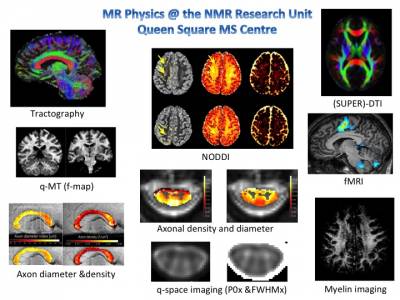The NMR Research Unit based at the UCL Institute of Neurology has a strong tradition of methodological development for quantitative Magnetic Resonance Imaging (MRI) and Magnetic Resonance Spectroscopy (MRS) methods in the central nervous system (CNS).
The Physics team is led by Professor Claudia Gandini Wheeler-Kingshott, who is Professor of MR Physics and has been at the UCL QS IoN since 1999, when she joined as Post Doctoral fellow. The MR Physics team currently counts on 6 Post Doctoral researchers and 5 PhD students, and fits within the thriving MR Physics community at Queen Square with collaborations within the Division of Neuroradiology and Neurophysics (UCL QS IoN) and across Faculties, in particular with the Centre of Medical Image Computing (CMIC) (Faculty of Engineering).
The team is particularly focused on developing, implementing and translating methods for studying a number of pathophysiological processes occurring in multiple sclerosis (MS), using standard and advanced imaging techniques applied to brain and spinal cord, as well as optic nerve wherever possible.
Methods include:
- Microstructural imaging using models of water diffusion in tissue;
- Myelin imaging, exploiting the magnetisation transfer phenomenon;
- Tissue loss, through brain atrophy from high resolution imaging;
- Sodium imaging and spectroscopy;
- Functional imaging, both task dependent and resting state;
- Metabolite quantifications.
The Unit currently has a number of Postdoctoral Fellows and also Ph.D. and M.Sc. students working in a truly translational environment where Physicists, Computer Scientists and Clinical Fellows are working in a joint effort to resolve key research questions in MS.
A wide range of imaging techniques for studies on MS are currently utilized in the MR Physics @ NMR Research Unit as shown:

 Close
Close

